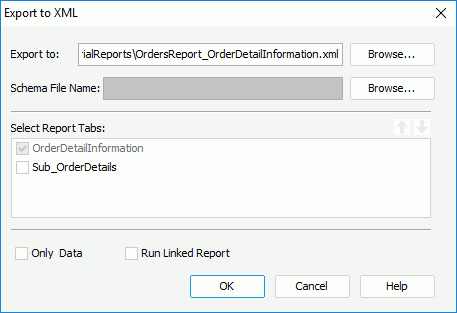Exporting to XML
This topic introduces how to export the results of a report to an XML format file.
- Open the report that you want to export.
- Select File > Export > To XML. The Export to XML dialog appears.

- Select the Browse button to specify the destination directory and file name of the exported XML file. You can also input the location and file name in the Export to text box manually (make sure that the folder you specify does exist, otherwise an error message will be produced).
- In the Schema File Name text box, specify an XSD file to export the web report or report tab to an XML file based on the specified XSD file.
- If you are exporting a page report, in the Select Report Tabs box, select the report tabs in the page report you want to export. The selected report tabs will be exported in the list order. You can select
 or
or  to change the order of the report tabs.
to change the order of the report tabs. - Check the Only Data checkbox to only export data of the web report or report tab.
- Check Run Linked Report if you want to include the reports that is linked with the report (not including the detail reports) in the XML result. If you are only interested in the primary report, leave this option unchecked. Generating linked reports at the same time, especially when the linked reports contain a large amount of data, will cause performance issue.
- Select OK to start exporting.
You should pay attention to the following when using the Export to XML feature:
- The existing schema file that you specify must also be generated from the web report or report tab. If you use other schema files, a NullPointerException exception will be thrown out.
- If the existing schema file that you specify contains only data, and you have cleared the Only Data checkbox in the Export to XML dialog, the exported XML file will then only contain database column information. The content of the exported XML file will be consistent with the schema file it is based on.
- If you delete an element node or an attribute node from the existing schema file, the exported XML file which is based on it, will not contain the corresponding column. In a not only data schema file, only the removal of an element used in a formula control property will affect an exported XML file which is based on it.
Example: Deleting an element node from a schema file affects the exported XML file which is based on it
Let's take Employee Information List.cls as an example.
- Select File > Open.
- In the Open Report dialog, select the Browse button to open the catalog file SampleReports.cat in
<install_root>\Demo\Reports\SampleReports, then open the sample report Employee Information List.cls. - Export Employee Information List.cls to an XML file. You will then get two files: Employee Information List_Employee Information.xml and Employee Information List_Employee Information.xsd.
- Open the Employee Information List_Employee Information.xsd file, and delete Employee Information List_Employee Information_ReportBody_PagePanel_PageHeaderPanel_ label4 from Employee Information List_Employee Information_ReportBody_PagePanel_PageHeaderPanel.
- Export Employee Information List.cls to an XML file again. This time, specify the modified Employee Information List_Employee Information.xsd as the file to base it on.
The newly exported Employee Information List_Employee Information.xml file will not contain information about Employee Information List_Employee Information_ReportBody_PagePanel_PageHeaderPanel_ label4.
- If you do not want to see all the property values in a generated XML file, you can comment out any unwanted properties in this way:
- Open the file JRXMLTag.properties located in resource_en_US.jar in
<install_root>\lib. - Add a question mark in front of any unwanted properties to comment them out. See below:
Change: Suppressed=Suppressed
To: ?Suppressed=Suppressed
- When you export the web report or report tab to XML, the exported XML file will not contain the property Suppressed for each report object.
- Save the property file and refresh the one in resource_en_US.jar.
In addition, when you uncheck Only Data, and add an @ sign in front of the value in JRXMLTag.properties, the property listed in the Element node will then move to the Attribute node.
For example, in JRXMLTag.properties,
Change: StartYPos=StartYPos
To: StartYPos=@StartYPos
You will now find that the StartYPos property is now listed in the Attribute node.
Before adding the @ sign in front of the value, the StartYPos property will have been listed in the Element node.
- Open the file JRXMLTag.properties located in resource_en_US.jar in
 Previous Topic
Previous Topic